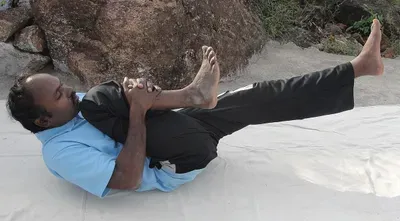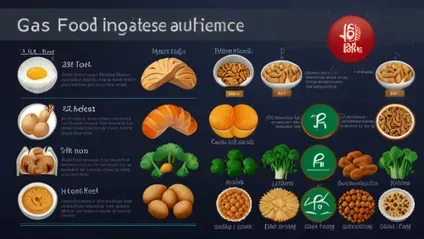Breathe Easy: Top Yoga Poses To Relieve Gas Quickly
Table Of Contents:
Understanding Gas and Its Common Causes
The Benefits of Yoga for Digestion
- How Yoga Aids in Digestive Health
Child's Pose: A Gentle Stretch
- Finding Comfort and Easing Discomfort
Wind-Relieving Pose (Pavanamuktasana)
- Targeting Trapped Gas Effectively
Supine Spinal Twist (Supta Matsyendrasana)
- Promoting Digestion Through Twisting Action
Cat-Cow Stretch: Mobilizing the Spine
- Enhancing Flexibility and Relieving Tension
Seated Forward Bend (Paschimottanasana)
- Encouraging Relaxation and Abdominal Stretch
Conclusion
- Incorporating Yoga into Your Routine for Relief
Embracing Yoga for Digestive Health

When we think of yoga, the first images that come to mind often include serene landscapes and flowing movements to enhance flexibility and mindfulness. However, many don’t realize that some poses can serve as powerful tools for addressing more immediate, yet common discomforts specifically, gas.
As our bodies process food throughout the day, trapped air can lead to bloating and abdominal pain. The good news? Yoga offers a natural remedy that promotes digestive health while nurturing our mental well-being.
Beyond merely relieving physical discomfort, the practice of yoga encourages us to listen to our bodies. Certain poses gently stimulate the digestive system and facilitate movement within the gastrointestinal tract, allowing for trapped gas to be released more effortlessly.
Moreover, engaging in these postures fosters an environment where stress is reduced; since anxiety can exacerbate digestive issues, finding calm through breathwork complements each pose beautifully.
So not only are we providing our body with relief but also cultivating a deeper awareness of how tension manifests within it a holistic approach indeed!
Understanding Gas And Its Common Causes
Gas is a natural byproduct of digestion, but understanding its common causes can help you manage discomfort more effectively. From the food we eat to lifestyle choices, several factors contribute to increased gas levels in the digestive system.
For instance, high-fiber foods and certain carbohydrates – such as beans, lentils,
and cruciferous vegetables – while healthy, can sometimes overwhelm the gut bacteria responsible for fermenting them. This fermentation process produces gas that can lead to bloating and discomfort.

Additionally, habits like eating too quickly or talking while chewing can introduce excess air into your digestive tract, exacerbating the problem further. Food intolerances are another hidden culprit; lactose intolerance or gluten sensitivity often leads to gas amidst other symptoms when trigger foods are consumed.
Understanding these triggers allows you to make informed dietary choices and mindfulness practices that promote better digestion and reduce gas build-up over time. Incorporating yoga poses designed to encourage movement through the digestive system can then serve as an effective remedy after addressing these underlying causes.
The Benefits Of Yoga For Digestion
Yoga offers a holistic approach to digestion, seamlessly integrating body and mind to enhance gastrointestinal health. Poses such as Cat-Cow and Seated Forward Bend not only stretch and strengthen the abdominal muscles but also stimulate peristalsis the wave-like contractions that move food through the digestive tract.
This gentle movement encourages blood flow to the digestive organs, optimizing their function and helping alleviate issues like bloating and discomfort.
Moreover, yoga emphasizes breath control also known as pranayama which can significantly impact digestion. Deep breathing techniques foster relaxation, reducing stress hormones that often hinder digestive processes.
As you cultivate mindfulness on your mat, you may find yourself tuning into your body's hunger signals more effectively, leading to healthier eating habits overall. Integrating these practices can transform your relationship with food from one of tension and anxiety into one rooted in awareness and balance, ultimately nurturing both body and spirit.
How Yoga Aids In Digestive Health
Yoga serves as a gentle yet effective way to nurture digestive health, seamlessly integrating movement with breath to stimulate the vital organs involved in digestion. By embracing specific poses that target the abdomen, such as Downward Dog and Supine Twist, practitioners can encourage the flow of energy and blood to these areas, promoting efficient digestion.
Each movement not only alleviates uncomfortable gas buildup but also enhances overall gut function by gently massaging internal organs.
The connection between breathwork and digestion is equally significant; deep, intentional breathing promotes relaxation and triggers the parasympathetic nervous system, often referred to as the rest and digest mode.
This shift in focus reduces stress levels which can wreak havoc on digestive processes allowing your body to absorb nutrients more effectively while minimizing discomfort.
So next time bloating strikes or you feel a wave of unease after eating, consider rolling out your yoga mat instead of reaching for medication; your body will thank you for this mindful approach to wellness.
Child's Pose: A Gentle Stretch
Child's Pose is more than just a resting position; it’s a gentle stretch that invites your body to unwind and release tension while promoting relaxation. As you fold forward into this pose, your abdomen gently compresses against your thighs, encouraging the movement of gas and easing bloating.
This simple yet effective stretch creates an environment within your body that fosters digestion, making it particularly beneficial after meals when gas tends to build up.
Moreover, Child's Pose provides a sanctuary for the mind as well as the body. The calming effect of resting your forehead on the mat can stimulate a sense of grounding and tranquillity, which is essential for relieving stress-induced digestive issues.
Breathing deeply in this position not only helps oxygen flow freely but also allows you to connect with each breath, further enhancing its soothing effects on both physical discomfort and mental strain.
So next time you're feeling gassy or bloated, remember that beneath its simplicity lies the powerful potential for relief and rejuvenation through Child's Pose.
Finding Comfort And Easing Discomfort
Finding comfort in moments of discomfort can be challenging, yet it's essential for holistic well-being. Instead of merely suppressing unease, embracing your body’s signals through mindful practices like yoga fosters a deeper connection with yourself.
As you flow through poses that promote digestion and relaxation, such as Wind-Relieving Pose and Knee-to-Chest, you initiate gentle movements that encourage the release of trapped air. This physical interaction not only alleviates gas but also invites awareness of your bodily sensations.
Moreover, engaging in deep breathing techniques during these poses cultivates internal calmness, allowing you to process discomfort without judgment. Imagine inhaling deeply, inviting revitalizing energy into tired limbs while exhaling the tension surrounding a bloated stomach this rhythm creates a meditative space where discomfort is transformed into acceptance.
By focusing on breath and body alignment, you're reminded that every sensation carries valuable information; understanding this can elevate your routine from mere exercise to an enriching self-care ritual.
Ultimately, finding comfort amid unease isn't just about the relief it brings; it's about fostering resilience within ourselves.
Each time we attend to our bodies’ needs through conscious movement and breathwork, we build a toolkit for managing not only physical discomfort but emotional turbulence as well. This journey invites us to explore the power of presence a simple act that allows healing energy to flow unimpeded throughout our lives.
Wind-Relieving Pose (Pavanamuktasana)
The Wind-Relieving Pose, known as Pavanamuktasana, is a powerful yet gentle asana that expertly targets gas relief while also promoting relaxation and mindfulness.
As you draw your knees toward your chest while lying on your back, imagine not just expelling trapped air but also releasing the tension that often accompanies digestive discomfort.
This pose offers a unique blend of physical release and mental clarity ideal for those moments when stress compounds digestive issues.
Incorporating deep breaths into Pavanamuktasana can elevate its benefits even further. As you inhale, visualize inviting in calmness and ease; with each exhale, consciously let go of any lingering unease in your abdomen.
You may find that this connection between breath and body amplifies the pose’s soothing effects not only alleviating bloating but also fostering an overall sense of well-being.
Permitting yourself to unwind in this pose can help to transform it from a mere physical practice into a profound restorative experience that uplifts both body and spirit.
Targeting Trapped Gas Effectively
Incorporating yoga into your routine can be a game-changer when it comes to managing trapped gas. The beauty of yoga lies not only in its physical postures but also in its ability to promote mindful breathing and relaxation, which are crucial for easing digestive discomfort.
Poses like the Wind-Relieving Pose (Pavanamuktasana) directly address the issue by gently compressing the abdomen, helping to release built-up air pockets while simultaneously facilitating detoxification through breath control.
Moving beyond just classic poses, consider integrating dynamic movements that stimulate digestion, such as Cat-Cow stretches or gentle twists. These flows create a rhythm that actively massages the intestines and encourages movement within the digestive tract.
Furthermore, don’t underestimate the power of restorative poses like Viparita Karani (Legs-Up-the-Wall), which fosters relaxation in both body and mind, allowing stress—often a contributor to gastrointestinal issues to melt away naturally.
Lastly, remember that hydration plays a vital role in digestion. Pair your yoga practice with a mindful sipping of warm lemon water or herbal teas throughout the day to keep your digestive system functioning optimally. This holistic approach not only targets trapped gas effectively but also nurtures overall wellness and balance within your body.
Supine Spinal Twist (Supta Matsyendrasana)
The Supine Spinal Twist, or Supta Matsyendrasana, is more than just a delightful way to unwind after a long day; it’s an effective tactic for promoting digestive health and alleviating gas discomfort.
As you lie on your back and gently draw one knee across your body towards the floor, the rotation of your spine stimulates the abdominal organs, helping them release trapped air and gas. This pose not only enhances circulation but also allows for a deep stretch throughout your back, assisting in the overall relaxation of both body and mind.
Incorporating mindful breathing while in this pose amplifies its benefits. Each inhalation can be used to lengthen and expand through your ribcage, while every exhalation allows for a deeper twist. This rhythmic maneuvering releases tension not just physically, but emotionally allowing for an experience that balances stress relief with digestive support.
Additionally, consider holding the position longer than usual; anchoring yourself in stillness encourages greater awareness of any sensations within your belly, offering immediacy to connect with what you might need at that moment.
Thus, Supta Matsyendrasana becomes a holistic tool you’re not just relieving gas; you’re nurturing mindfulness through self-awareness on multiple levels.
Promoting Digestion Through Twisting Action
Twisting yoga poses are a game-changer when it comes to promoting digestion and easing discomfort caused by gas. These poses create a gentle compression in the abdominal area, stimulating the digestive organs and helping to release trapped air.
When you twist your body, you're not just engaging your muscles; you're also gently massaging your intestines, encouraging better movement through the gastrointestinal tract. The result? A natural boost in digestion that can lead to significant relief.
Moreover, incorporating breath with these twists amplifies their benefits. As you inhale deeply while twisting, your rib cage expands, enhancing circulation and oxygen flow throughout your body. This improved blood flow invigorates the digestive system further, making every exhale an opportunity to release not just tension but also accumulated gas.
Consider integrating twists like Bharadavajasana (Sitting Twist) or Ardha Matsyendrasana (Half Lord of the Fishes Pose) into your routine not merely as exercises but as mindful practices that nurture both body and mind. Embracing this holistic approach allows you to transform discomfort into ease while cultivating a deeper connection with how your body functions.
Cat-Cow Stretch: Mobilizing The Spine
The Cat-Cow stretch, often heralded as a cornerstone of yoga practice, is not just a flow for spinal mobility; it's a dynamic dance of opposites that fosters deeper mind-body awareness.
As you transition between the rounded arch of the Cat pose and the gentle sway of the Cat-Cow pose, you engage both the front and back lines of your body in a harmonious rhythm. This movement creates space within the abdominal cavity, aiding digestion and promoting an effortless release of trapped gas.
What sets this stretch apart from others is its capacity to ground us in our breath. Each inhale inflates your belly while inviting creativity and openness, whereas exhaling allows for tension release perfect for addressing that uncomfortable bloating we sometimes feel.
With each cycle, you're not only loosening tightness in your spine but also encouraging energetic flow through your digestive tract.
Consider incorporating some playful variations into your practice: try holding each position longer or incorporating gentle lateral movements as you go through the sequence.
These subtle shifts can enhance circulation throughout the torso while reminding you to stay present and attentive to how your body responds a key ingredient in fostering ease at every level. Embrace this duality with intention; let it be both a physical exercise and an invitation to listen more closely to what your body needs.
Enhancing flexibility And Relieving Tension
Enhancing flexibility in your body plays a crucial role not just in improving overall physical health but also in aiding the digestive system. Many may not realize that tight muscles, particularly around the core and hips, can contribute to gastrointestinal discomfort.
By incorporating yoga poses that target these key areas, you create space within your body, allowing for better circulation and reduced tension. Furthermore, when muscle fibers stretch and relax, they promote deeper breathing a vital component of digestion.
From a mental perspective, embracing flexibility goes beyond physical movement; it cultivates an attitude of adaptability and openness. Engaging fully in poses like the Cat-Cow or Pigeon encourages mindfulness that can alleviate the stress often associated with digestive issues.
Each time you breathe deeply into these stretches, you release pent-up energy and emotions that could exacerbate tension in your abdomen. So next time you're feeling tense or bloated, remember that tuning into your breath while enhancing flexibility is a holistic approach countering both physical discomfort and emotional strain while inviting tranquillity back into your life.
Seated Forward Bend (Paschimottanasana)
Seated Forward Bend, or Paschimottanasana, is more than just a stretch; it’s an invitation to turn inward and foster deep mindfulness. As you sit with your legs extended before you and slowly hinge at the hips to reach for your toes, you cultivate a profound connection between body and breath.
This pose not only elongates the spine but also gently massages the digestive organs, promoting improved circulation that can aid in releasing trapped gas.
Interestingly, the calming nature of Paschimottanasana goes beyond physical benefits it encourages introspection. The forward fold invites a sense of surrender, creating space for emotional release as well.
Practicing this pose mindfully allows you to observe any discomfort within yourself without judgment, fostering awareness that can translate into better self-care habits off the mat.
Pairing this pose with deep diaphragmatic breathing helps soothe nervous energy and promotes relaxation a powerful duo when facing digestive disturbances.
Encouraging Relaxation And
Abdominal Stretch
One of the most effective yet often overlooked practices to encourage relaxation and provide abdominal relief is the subtle art of mindful breathing. As you settle into a comfortable seated or reclining position, close your eyes gently and focus on inhaling deeply through your nose, allowing your abdomen to expand fully.
Visualize a wave of relaxation washing over you with each exhale, releasing tension not just in your mind but also within the digestive system. This ritual of leaning over to one side while reaching up with the opposite arm creates space in your tor can be enhanced by incorporating soft side stretches; simply so, inviting gentle movement that may aid in alleviating discomfort.
Engaging in simple props like pillows or bolsters can deepen this experience even further. Placing a bolster beneath your knees while lying on your back encourages a gentle opening of the hips, minimizing pressure on the abdomen while simultaneously promoting tranquillity.
Alternatively, consider taking time for Child’s Pose this restorative position allows gravity to work its magic as it subtly compresses and massages vital organs while fostering an environment for calmness and surrender.
Adding elements like essential oils or soft music can transform these moments into a holistic retreat that nurtures both body and mind, leaving you feeling refreshed and relieved from any lingering discomfort.
A Holistic Approach To Relieving Gas And Nurturing Wellness
In conclusion, embracing yoga not only aids in relieving gas but also fosters a deeper connection between the mind and body. By incorporating these specific poses into your daily routine, you invite a gentle release of tension while simultaneously enhancing digestive efficiency.
This holistic approach to wellness encourages a more mindful practice that prioritizes self-care and awareness.
Beyond their immediate benefits for gas relief, these yoga postures can serve as powerful tools in our overall health arsenal. Regular practice creates space for introspection, allowing us to tune into our bodies signals and respond with compassion.
So next time discomfort arises, remember that finding solace on your mat may hold the key not just for alleviating gas, but for nurturing a calmer mind and resilient body. Embrace this journey towards balance; each breath is an opportunity to heal from within.
Incorporating yoga into your routine for relief
Incorporating yoga into your daily routine can be a transformative practice not just for your body, but also for your mind and digestive health. Setting aside time for focused breathing exercises and gentle stretches helps cultivate mindfulness, which can lead to improved digestion.
By honing in on the sensations within your abdomen, you may discover subtle tensions or discomforts that often accompany gas buildup. This awareness allows you to address these issues proactively rather than reactively.
Moreover, integrating specific poses like Child’s Pose or Wind-Relieving Pose into your morning ritual can set a calming tone for the day. These positions encourage intuitive movement while promoting relaxation in both body and mind.
As you harmonize breath with movement, you'll find not only relief from cumulative stress but also an enhanced ability to listen to what your body needs be it more hydration, dietary changes, or simple adjustments in posture throughout the day.
Embrace this holistic approach; after all, yoga is about fostering balance and well-being in all aspects of life.
People Also Asked
What causes gas in the digestive system?
- Gas is caused by swallowed air and the breakdown of certain foods in the large intestine.
How does yoga help relieve gas?
- Yoga promotes the movement of gas through gentle stretches and poses that stimulate the digestive system.
Which yoga pose is best for relieving gas quickly?
- The Wind-Relieving Pose (Pavanamuktasana) is highly effective for quick relief from gas.
How often should I practice yoga for digestive health?
- Practicing yoga daily or several times a week can significantly improve digestive health.
Can yoga help with bloating?
- Yes, yoga can help reduce bloating by encouraging the movement of gas and reducing stress.
Is yoga safe for everyone to practice?
- While yoga is generally safe, it’s important to consult with a healthcare provider before starting if you have any medical conditions.
What other benefits does yoga offer for digestion?
- Yoga improves overall digestive function, reduces stress, and promotes better eating habits.
Can children practice yoga for gas relief?
- Yes, children can practice gentle yoga poses under the guidance of a qualified instructor.
How long does it take to feel the effects of yoga on digestion?
- Some people may feel relief immediately, while others may notice improvements over a few weeks of regular practice.
Are there any dietary tips to complement yoga for better digestion?
- Yes, eating slowly, avoiding gas-producing foods, and staying hydrated can complement yoga for better digestion.





